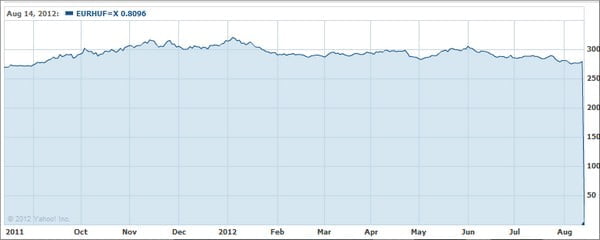One of the most important subjects a blog can write about is money; everyone is interested in the subject and everyone likes to have money, and most of us like it even more if they have a lot of it. Since Hungary is not the largest and most important country in the world, many people ask themselves questions such as where is Hungary, what is the capital of Hungary and of course, what is the currency of Hungary. In our blog we will from time to time simply answer such normal and typical questions, though not with short answers, but with thorough information helping our readers find exactly the information they want and need.
So, what is the currency of Hungary?
The name of the currency used in Hungary is Hungarian Forint, which has been used since 1946. Before that the currency of Hungary was Adópengő, and before that they used Forint (1867-1892), Korona (1892-1918), Pengő (1919-1926) and then Adópengő (1927-1946) before the Forint finally became the currency of Hungary again in 1946. Currently the Hungarians would like to get the Euro as their local currency, so the end of the HUF might be on the horizon, but they have not yet been allowed to get it due to poor economy. But, if the economy starts rising, the Euro might come to Hungary as well in the future, thus making and end to the epoch of the Hungarian Forint.
The Hungarian Forint is often named only HUF which is the abbreviation for the real name, just like the Great British Pound is often shortened down to GBP. Another sign for the Hungarian Forint is Ft, which you can often see on price tags in both stores and on the internet and elsewhere. Earlier the currency of Hungary had a smaller part named fillér, where one Forint was the same as 100 fillér. The last fillér was withdrawn from usage in 1999. After that the smallest coin was the 1 Forint coin (0,0036 Euro or 0,0045 USD). The 1 and 2 Forint coins remained in circulation until 1998, but since then the 5 Forint coin is the smallest still in circulation.
So if you come to Hungary know you can find 5, 10, 20, 100 and 200 Forint coins and 500, 1000, 2000, 5000, 10000 and 20000 HUF bills. One piece of advice is if you jump on a taxi on the street or pay with larger bills in strange, hidden shops and at markets, is to make sure that you receive money back in Hungarian Forint. Some people we know have paid taxis with a Hungarian 20,000 bill and received back 10,000 Romanian Lei bill (which is worth nothing at all). This is not very common, but it happens, so it is worth watching out.
USD to HUF
If you would like to change your USD to HUF at the moment you can multiply the amount in USD with 225, and you will get almost the exact amount in HUF. This means that if you would like to change 200 USD to HUF then you will get somewhere around 45,000 HUF. It is not that easy with brain math, but if you remember the trick of multiplying with 225 and use the calculator at your mobile that should be of great help.
EUR to HUF
If you come from a European country with EUR (Euro) as the local currency then 1 Euro is at moment around 280 HUF. That is in fact a quite big difference to some months ago, because then you could in the most drastic times of Hungarian economy get 320 HUF for 1 Euro. Beneath this text you can find a graph showing the movement and changes in the relationship between the Euro and the Hungarian Forint in the last two years.

GBP to HUF
Budapest is a very popular destination for people coming in from Great Britain and there are quite a lot of pubs packed with Englishmen drinking bear and having fun. But to buy the beer you need to have some of the Hungarian currency, and if you want to change GBP to HUF then you should calculate that 1 GBP gives you about 350 HUF. If you then change 200 GBP you should get about 70,000 HUF.
Be aware!
When reading about the conversion from USD to HUF, from EUR to HUF or from GBP to HUF we have the ideal and current exchange middle rates. If you go to an exchange office at the airport they will have terrible rates compared to this, and even though it is not normal with commission rates at the exchange offices, they still have horrible exchange rates making up for the „no commission” sign. The best way to grab hold of the currency of Hungary, the HUF, is to use an ATM either at the airport or in the city center, or maybe by finding good exchange offices where the difference between the buy and sale price is nothing more than 3-4 Forint. You can read more about it this at the Currency page at Budapest Guide where you can also find an online currency converter.

Thanks for the information about currency in Hungary